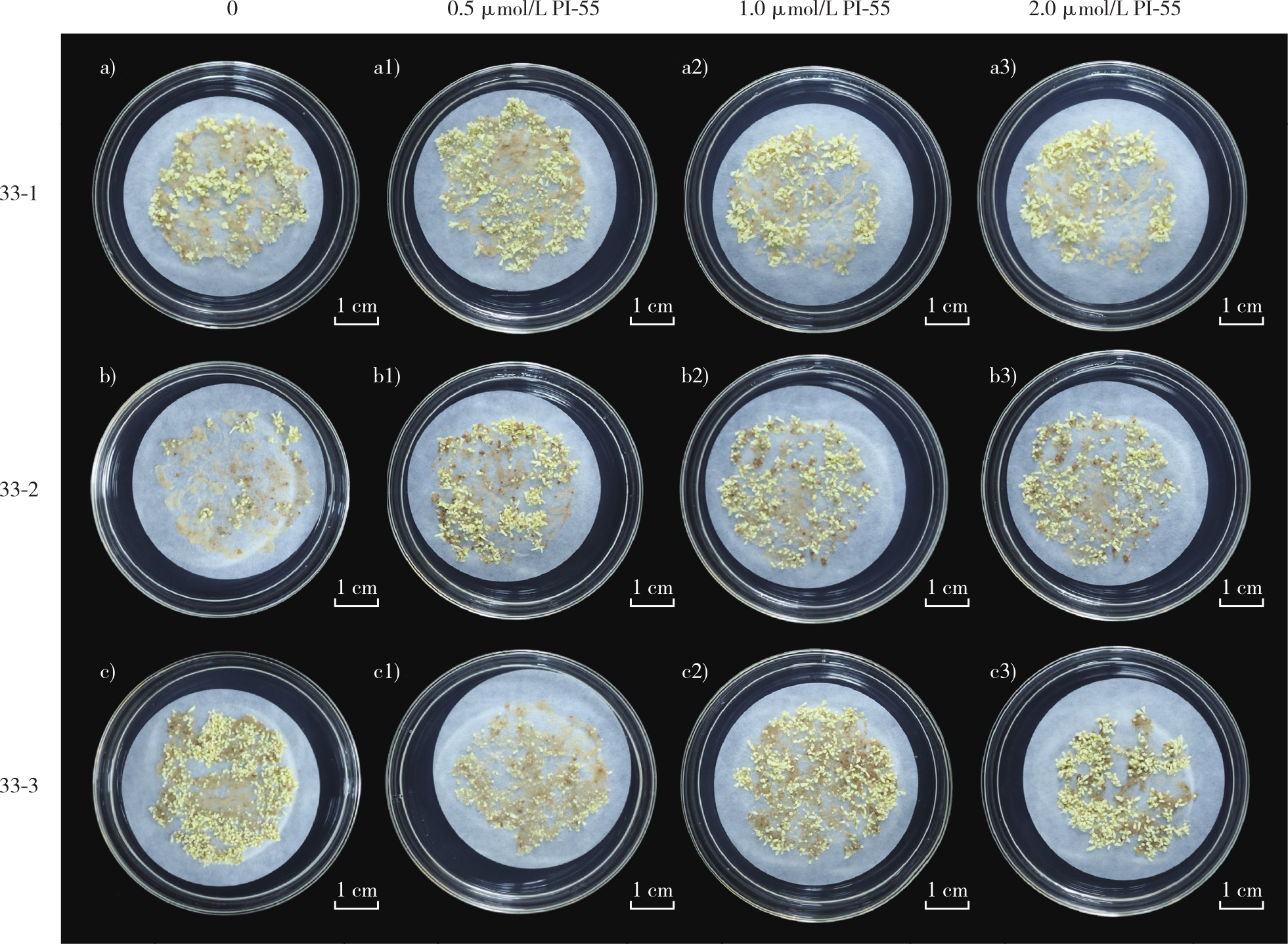 PDF(13162 KB)
PDF(13162 KB)


PI-55对欧洲云杉胚性愈伤组织增殖的作用研究
陈千敏, 周艳萍, 李涵宇, 沈森琪, 张楚焮, 邓成, 李青粉
南京林业大学学报(自然科学版) ›› 2025, Vol. 49 ›› Issue (4) : 88-96.
 PDF(13162 KB)
PDF(13162 KB)
 PDF(13162 KB)
PDF(13162 KB)
PI-55对欧洲云杉胚性愈伤组织增殖的作用研究
Research on the role of PI-55 in the embryonic callus proliferation of Picea abies
【目的】探究6-(2-羟基-3-甲基苄基氨基)嘌呤(PI-55)对欧洲云杉(Picea abies)胚性愈伤组织在长期增殖和体细胞胚分化的影响,旨在为提高重要针叶树体胚发生及大规模再生技术效率提供科学参考。【方法】以欧洲云杉33号基因型的成熟合子胚诱导出的胚性愈伤组织为试验材料,在增殖期间添加不同浓度(0、0.5、1.0和2.0 μmol/L)PI-55培养14 d后,通过检测、分析对比相关生理生化指标,探讨PI-55对胚性愈伤组织内源激素(IAA、CTK、ZR、ABA)、抗氧化酶(SOD、POD、CAT)、可溶性蛋白及体细胞胚分化的影响。【结果】0.5~1.0 μmol/L PI-55可以提高欧洲云杉胚性愈伤的分化率,及其内源激素含量、抗氧化酶活性和可溶性蛋白含量;同时发现体胚分化能力弱的细胞系CTK和ZR含量、POD和CAT活性高于体胚分化能力强的细胞系,表明胚性愈伤组织需要一定水平的内源物质来促使体胚分化,但过高水平的内源物质则会抑制体胚分化。【结论】欧洲云杉体细胞胚发生过程中的增殖和分化阶段受多种因素的影响,PI-55可能是通过调节胚性愈伤组织的内源激素等生理指标进一步提高其分化能力,这一结果可为改良欧洲云杉体细胞胚发生技术,以及未来大规模生产和良种选育提供参考。
【Objective】To systematically investigate the impact of 6-(2-hydroxy-3-methylbenzylamino) purine (PI-55) on the development of embryogenic callus tissues in European spruce (Picea abies), this study examines both its role during extended periods of callus proliferation and its influence on the subsequent stages of somatic embryo differentiation. By analyzing the morphogenetic responses, cellular proliferation rates, and molecular regulatory mechanisms triggered by PI-55 treatment, this research aims to elucidate the compound’s potential to modulate key developmental processes in coniferous embryogenesis. The findings are anticipated to provide critical insights into optimizing somatic embryogenesis protocols for P. abies, offering a robust scientific foundation for enhancing the efficiency and reproducibility of large-scale plant regeneration techniques in this ecologically and economically important conifer species.【Method】Embryogenic callus tissue derived from mature zygotic embryos of the P. abies genotype 33 was selected as the experimental substrate to investigate the impact of 6-(2-hydroxy-3-methylbenzylamino)purine (PI-55) on callus proliferation and somatic embryo development. During the proliferation phase, callus cultures were supplemented with varying concentrations of PI-55 [0 (control), 0.5, 1.0 and 2.0 μmol/L] and maintained under controlled conditions for a duration of 14 days. Subsequent analyses involved comprehensive assessments of physiological and biochemical parameters, including endogenous phytohormone profiles (indole-3-acetic acid [IAA], cytokinins (CTK), zeatin riboside (ZR), and abscisic acid (ABA), antioxidant enzyme activities (superoxide dismutase (SOD), peroxidase (POD), and catalase (CAT)), soluble protein content, and somatic embryo maturation efficiency. These metrics were systematically quantified and compared across treatment groups to elucidate the concentration-dependent effects of PI-55 on callus tissue viability, hormonal balance, oxidative stress tolerance and embryogenic potential.【Result】The application of 0.5-1.0 μmol/L PI-55 has been shown to significantly enhance the differentiation rate of European spruce embryogenic callus. This effect is mediated through PI-55 ability to elevate endogenous hormone levels, antioxidant enzyme activities, and soluble protein content in the embryogenic callus. Notably, comparative analysis revealed that cell lines with weaker somatic differentiation capacity exhibited higher concentrations of cytokinins (CTK) and zeatin riboside (ZR), as well as greater peroxidase (POD) and catalase (CAT) activities compared to those with stronger differentiation potential. These findings suggest that while a certain threshold of endogenous substances is required to promote somatic embryogenesis, supraoptimal levels may conversely inhibit the differentiation process.【Conclusion】These insights provide a robust scientific framework for improving somatic embryogenesis protocols in European spruce. The elucidation of PI-55 regulatory role, in particular, offers valuable opportunities for developing enhanced tissue culture systems capable of large-scale propagation of superior genotypes. Such advancements will significantly contribute to modern breeding initiatives focused on producing improved spruce varieties, thereby meeting both ecological conservation objectives and the growing commercial requirements of the forestry and timber sectors. The potential applications of these findings extend to addressing current challenges in sustainable forest management and wood production.

欧洲云杉 / 胚性愈伤组织 / 增殖 / 内源激素 / 6-(2-羟基-3-甲基苄基氨基)嘌呤(PI-55) / 抗氧化酶 / 可溶性蛋白
European spruce (Picea abies) / embryogenic callus / maturation / endogenous hormones / 6-(2-hydroxy-3-methylbenzylamino) purine (PI-55) / antioxidant enzymes / soluble proteins
| [1] |
|
| [2] |
张丽娟. 欧洲云杉体胚再生技术构建[D]. 杨凌: 西北农林科技大学, 2023.
|
| [3] |
欧阳, 欧阳芳群, 孙猛, 等. 欧洲云杉无性系幼龄生长节律、年度和密度互作效应及选择策略[J]. 南京林业大学学报(自然科学版), 2023, 47(6):95-104.
|
| [4] |
麻文俊. 我国首个云杉国家良种通过审定[J]. 林业科技通讯, 2025(1):56.
|
| [5] |
|
| [6] |
|
| [7] |
|
| [8] |
|
| [9] |
|
| [10] |
|
| [11] |
许莹楠, 刘艳军, 黄俊轩, 等. 生长素和细胞分裂素诱导植物胚性愈伤组织研究进展[J]. 长江蔬菜, 2024(4):33-37.
|
| [12] |
|
| [13] |
|
| [14] |
王安旗. 红豆杉体细胞胚胎发生及转录组学分析[D]. 杨凌: 西北农林科技大学, 2024.
|
| [15] |
|
| [16] |
|
| [17] |
|
| [18] |
|
| [19] |
|
| [20] |
|
| [21] |
SERSHEN,
|
| [22] |
张天择, 王静娴, 聂昕茹, 等. 植物体胚发生及其分子调控机制研究进展[J]. 分子植物育种, 2023, 21(17):5677-5686.DOI: 10.13271/j.mpb.021.005677.
|
| [23] |
|
| [24] |
|
| [25] |
|
| [26] |
|
| [27] |
|
| [28] |
|
| [29] |
|
| [30] |
|
| [31] |
张莹莹. 湿地松胚性愈伤组织诱导和增殖初步研究[D]. 南昌: 江西农业大学, 2018.
|
| [32] |
|
| [33] |
|
| [34] |
曹茜. 北美兰云杉体胚发生关键技术优化及体胚分化阶段生理机制研究[D]. 长春: 吉林农业大学, 2022.
|
| [35] |
|
| [36] |
|
| [37] |
|
| [38] |
|
| [39] |
|
| [40] |
|
| [41] |
|
| [42] |
娜苏勒玛. 沙地云杉体细胞胚胎不同发育时期生理生化特性研究[D]. 呼和浩特: 内蒙古农业大学, 2019.
|
| [43] |
宋跃. 长白落叶松体细胞胚胎发生及遗传转化研究[D]. 哈尔滨: 东北林业大学, 2017.
|
| [44] |
|
| [45] |
任毓辉, 聂帅, 彭春雪, 等. 红松胚性愈伤组织增殖的激素配比、糖源类型和增殖周期效应研究[J]. 植物研究, 2022, 42(4):704-712.
|
/
| 〈 |
|
〉 |